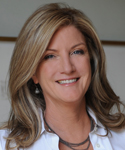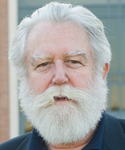Sneak preview for Rice community planned for May 5
When do blue skies turn pink? Or yellow? Or green? Or orange?
When they’re viewed from the new James Turrell skyspace – the latest and most elaborate addition to Rice University’s public art. This experiential work of art fuses light and space to enhance perception.
The highly anticipated skyspace does not open to the public until June 14, but Rice students, faculty and staff got a sneak preview May 5 during an exclusive Cinco de Mayo celebration for the Rice community.
Towering above a 12-foot-high grass berm just east of Rice’s Shepherd School of Music, the pyramid-like work of art will provide two light shows each day – one at sunrise and one at sunset – in conjunction with the arc of the sun. Visitors seated on the skyspace’s lower and upper viewing areas will gaze up at the 72-by-72-foot white roof, which offers a view of the sky through a 14-by-14-foot opening. Lights projected on the ceiling will change colors as the sun rises and sets, and these will impact the color of the sky as seen by visitors.
With a multimillion-dollar gift from Rice trustee and alumna Suzanne Deal Booth ’77, Rice commissioned celebrated American artist James Turrell to design the skyspace. Deal Booth and Rice alum Raymond Brochstein co-chaired the Rice Art Committee that led the efforts for development and construction of the skyspace.
“I wanted James to do something new and wonderful, and it’s even better than I expected,” Deal Booth said. “The light show changes our perception of things, and I love it. I’m delighted not just with the light show, but with the whole structure.”
Accessibility of the installation was important to Deal Booth, a native Texan who graduated cum laude from Rice with a B.A. in art history. She said she hopes that students will take advantage of the opportunity to walk into the skyspace as part of their daily lives, and that visitors will put the skyspace on their list of places to explore. “It’s interesting every time you see it,” she said.
Rice President David Leebron, who recently hosted a small pre-opening private viewing of the skyspace, said he expects the installation will be a frequent destination for students, faculty, staff and alumni, and also will draw visitors from the greater Houston community.
“The Turrell skyspace has already created tremendous excitement on our campus,” he said. “It is a great symbol of Rice’s aspirations as we enter our second century. It will be fascinating to see the many ways in which our campus community will interact with this magnificent work. It is a dramatic and inspiring addition to our campus public art and complements Rice’s many diverse efforts to fully engage the city and people of Houston. We hope the skyspace and other campus art will attract not only many Houstonians to our campus, but also many of the visitors who come to Houston each year.”
The skyspace can seat up to 120 people, with 44 in the lower viewing area, which is wheelchair-accessible, and 76 in the upper viewing area. When the skyspace opens to the public next month, admission will be free, but initially a ticketing system will be used to manage the large number of people expected.
University Art Director Molly Hipp Hubbard said the presence of a commissioned work on campus by the widely acclaimed Turrell will have a profound impact on the aesthetic quality of Rice’s public art program. “The Turrell skyspace offers an unforgettable experience, and the art community around the world is excited about it,” she said. “As this work of art was being built, I imagined that people would come from all over to view it, much like a pilgrimage site. And now that I have marveled at the stunning light show and the ingenious design of the structure and space, I can’t wait for others to share this experience.”
Thomas Phifer and Partners served as the architect for the skyspace, and Linbeck was the construction team. The roof is a composition of several specifically engineered materials with a carbon steel knife edge. The seating area on the lower level is made of pink and gray Texas granite from Marble Falls; on the upper level, poured-concrete benches provide seating. A sequence of LED lights installed in the upper level is programmed to create the light show on the ceiling in sync with sunset and sunrise. The light program can operate in a variety of weather conditions.
Over the past four decades, Turrell has created skyspaces in 25 countries. The skyspace at Rice is his 73rd and one of the largest. “Each is unique,” he said. “I wanted this one to feel open because it’s a very public space and at the same time it’s an enclosure.”
Turrell said the relation of inside to outside is very important. “This is one in which you will see the sky be almost any color you like, in fact, quite some surprising tones,” he said. “If you take a photo of the sky in this skyspace, the color you see in the opening is not actually going to show up in your camera because in fact it is not there.
“This is a gentle reminder that because we give the sky its color and can then change the color of the sky, we create the reality in which we live. The light that we make is something that changes the reality of how we perceive the sky. We do create the world in which we live to a much larger extent than we are willing to take responsibility for.”
Rice has the first Turrell skyspace to be engineered for acoustics. Twelve state-of-the-art speakers are “hidden” in the plaster walls. Although music will not be played during the sunset and sunrise light shows, Turrell is creating additional light shows for use by the Shepherd School of Music.
“We worked with James Turrell on the concept for the structure, and the internal viewing space was ideally constructed for acoustic purposes to accommodate live instruments,” said Robert Yekovich, dean of the Shepherd School and the Elma Schneider Professor of Music. “We plan to develop a concert series that will feature primarily acoustic performances like a string quartet or a woodwind trio and small-chamber ensembles.”
Kurt Stallmann, the Lynette S. Autrey Associate Professor of Composition and Theory and director of the Rice Electroacoustic Music Labs, has already composed a piece for the skyspace. Other Shepherd School composers also plan to create digital music to accompany different lighting sequences, Yekovich said.
“The space is unbelievably versatile and really quite extraordinary,” he said. “The multimedia capabilities offer many musical possibilities for us, and our performers and composers couldn’t be more thrilled.”
Turrell has amassed a large following since he began pursuing art at the Claremont Graduate School in California. A native of Los Angeles, Turrell has exhibited his works around the world. Among the places where his permanent installations are on view are the Guggenheim Museum in New York City, the Museum für Moderne Kunst in Frankfurt am Main, Germany, the Panza Collection in Varese, Italy, and the P.S.1 Contemporary Art Center in Long Island, N.Y., which houses one of his first skyspaces. In fact, Deal Booth helped build that skyspace as Turrell’s part-time assistant when she was a graduate student in art history and art conservation at the Institute of Fine Arts at New York University.
Turrell has two other major projects in Houston: the Live Oak Friends Meetinghouse and “The Light Inside,” an artificially lit interior installation at the Museum of Fine Arts, Houston. He named the skyspace at Rice “Twilight Epiphany.”
The skyspace is closed now for finishing touches in preparation for the public opening.
For more information on public art at Rice, visit publicart.rice.edu.







Leave a Reply